Schlafen Family Intra-Regulation by IFN-α2 in Triple-Negative Breast Cancer
Abstract
:Simple Summary
Abstract
1. Introduction
2. Methods
2.1. Cells and Reagents
2.2. Viral Constructs
2.3. siRNA Studies
2.4. qPCR
2.5. Cell Viability
2.6. Flow Cytometry
2.7. Statistical Analysis
3. Results
3.1. IFN-α2 Increases SLFN12 Expression and AdvShSLFN12 Prevents the IFN-α2 Associated Increase in SLFN12
3.2. IFN-α2 Continues to Be Effective in Decreasing TNBC Cell Viability Despite a Knockdown in SLFN12
3.3. SLFN Family mRNA Expression Variably Increases with Loss of SLFN12 and IFN-𝛼2 Signaling
3.4. SLFN11 and SLFN13 mRNA and Protein Expression Increase with IFN-𝛼2 Signaling
3.5. Apparent SLFN Interplay with IFN-α2 Signaling
3.6. IFN-𝛼2 Decreases TNBC Cell Viability with Simultaneous Knockdown of SLFN5, SLFN12, SLFN12-Like, and SLFN14
4. Discussion
5. Conclusions
Supplementary Materials
Author Contributions
Funding
Institutional Review Board Statement
Informed Consent Statement
Data Availability Statement
Conflicts of Interest
References
- American Cancer Society. About Breast Cancer; American Cancer Society: New York, NY, USA, 2023. [Google Scholar]
- Bianchini, G.; Balko, J.M.; Mayer, I.A.; Sanders, M.E.; Gianni, L. Triple-Negative Breast Cancer: Challenges and Opportunities of a Heterogeneous Disease. Nat. Rev. Clin. Oncol. 2016, 13, 674–690. [Google Scholar] [CrossRef] [PubMed]
- Al-Marsoummi, S.; Vomhof-DeKrey, E.; Basson, M.D. SchlafEN12 Reduces the Aggressiveness of Triple Negative Breast Cancer through Post-Transcriptional Regulation of ZEB1 That Drives Stem Cell Differentiation. Cell. Physiol. Biochem. 2019, 53, 999–1014. [Google Scholar] [CrossRef] [PubMed]
- Baranova, A.; Krasnoselskyi, M.; Starikov, V.; Kartashov, S.; Zhulkevych, I.; Vlasenko, V.; Oleshko, K.; Bilodid, O.; Sadchikova, M.; Vinnyk, Y. Triple-Negative Breast Cancer: Current Treatment Strategies and Factors of Negative Prognosis. J. Med. Life 2022, 2022, 153–161. [Google Scholar] [CrossRef] [PubMed]
- Hudis, C.A.; Gianni, L. Triple-Negative Breast Cancer: An Unmet Medical Need. Oncologist 2011, 16, 1–11. [Google Scholar] [CrossRef] [PubMed]
- Al-Marsoummi, S.; Vomhof-Dekrey, E.E.; Basson, M.D. Schlafens: Emerging Proteins in Cancer Cell Biology. Cells 2021, 10, 2238. [Google Scholar] [CrossRef] [PubMed]
- Elsayed, A.A.R.; Al-Marsoummi, S.; Vomhof-Dekrey, E.E.; Basson, M.D. SLFN12 Over-Expression Sensitizes Triple Negative Breast Cancer Cells to Chemotherapy Drugs and Radiotherapy. Cancer Genom. Proteom. 2022, 19, 328–338. [Google Scholar] [CrossRef] [PubMed]
- Al-Marsoummi, S.; Pacella, J.; Dockter, K.; Soderberg, M.; Singhal, S.K.; Vomhof-Dekrey, E.E.; Basson, M.D. Schlafen 12 Is Prognostically Favorable and Reduces C-Myc and Proliferation in Lung Adenocarcinoma but Not in Lung Squamous Cell Carcinoma. Cancers 2020, 12, 2738. [Google Scholar] [CrossRef] [PubMed]
- Jo, U.; Pommier, Y. Structural, Molecular, and Functional Insights into Schlafen Proteins. Exp. Mol. Med. 2022, 54, 730–738. [Google Scholar] [CrossRef]
- Vomhof-DeKrey, E.E.; Lee, J.; Lansing, J.; Brown, C.; Darland, D.; Basson, M.D. Schlafen 3 Knockout Mice Display Gender-Specific Differences in Weight Gain, Food Efficiency, and Expression of Markers of Intestinal Epithelial Differentiation, Metabolism, and Immune Cell Function. PLoS ONE 2019, 14, e0219267. [Google Scholar] [CrossRef]
- Chaturvedi, L.; Sun, K.; Walsh, M.F.; Kuhn, L.A.; Basson, M.D. The P-Loop Region of Schlafen 3 Acts within the Cytosol to Induce Differentiation of Human Caco-2 Intestinal Epithelial Cells. Biochim. Biophys. Acta Mol. Cell Res. 2014, 1843, 3029–3037. [Google Scholar] [CrossRef]
- Aricò, E.; Castiello, L.; Capone, I.; Gabriele, L.; Belardelli, F. Type i Interferons and Cancer: An Evolving Story Demanding Novel Clinical Applications. Cancers 2019, 11, 1943. [Google Scholar] [CrossRef] [PubMed]
- Badiger, R.; Mitchell, J.A.; Gashaw, H.; Galloway-Phillipps, N.A.; Foser, S.; Tatsch, F.; Singer, T.; Hansel, T.T.; Manigold, T. Effect of Different Interferonα2 Preparations on IP10 and ET-1 Release from Human Lung Cells. PLoS ONE 2012, 7, e46779. [Google Scholar] [CrossRef] [PubMed]
- Barton, V.N.; D’Amato, N.C.; Gordon, M.A.; Lind, H.T.; Spoelstra, N.S.; Babbs, B.L.; Heinz, R.E.; Elias, A.; Jedlicka, P.; Jacobsen, B.M.; et al. Multiple Molecular Subtypes of Triple-Negative Breast Cancer Critically Rely on Androgen Receptor and Respond to Enzalutamide in Vivo. Mol. Cancer Ther. 2015, 14, 769–778. [Google Scholar] [CrossRef] [PubMed]
- Wang, W.; Han, D.; Cai, Q.; Shen, T.; Dong, B.; Lewis, M.T.; Wang, R.; Meng, Y.; Zhou, W.; Yi, P.; et al. MAPK4 Promotes Triple Negative Breast Cancer Growth and Reduces Tumor Sensitivity to PI3K Blockade. Nat. Commun. 2022, 13, 245. [Google Scholar] [CrossRef] [PubMed]
- Basson, M.D.; Wang, Q.; Chaturvedi, L.S.; More, S.; Vomhof-Dekrey, E.E.; Al-Marsoummi, S.; Sun, K.; Kuhn, L.A.; Kovalenko, P.; Kiupel, M. Schlafen 12 Interaction with SerpinB12 and Deubiquitylases Drives Human Enterocyte Differentiation. Cell. Physiol. Biochem. 2018, 48, 1274–1290. [Google Scholar] [CrossRef] [PubMed]
- Vomhof-DeKrey, E.E.; Stover, A.D.; Labuhn, M.; Osman, M.R.; Basson, M.D. Vil-Cre Specific Schlafen 3 Knockout Mice Exhibit Sex-Specific Differences in Intestinal Differentiation Markers and Schlafen Family Members Expression Levels. PLoS ONE 2021, 16, e0259195. [Google Scholar] [CrossRef]
- Vomhof-DeKrey, E.E.; Lansing, J.T.; Darland, D.C.; Umthun, J.; Stover, A.D.; Brown, C.; Basson, M.D. Loss of Slfn3 Induces a Sex-Dependent Repair Vulnerability after 50% Bowel Resection. Am. J. Physiol. Gastrointest. Liver Physiol. 2021, 320, G136–G152. [Google Scholar] [CrossRef] [PubMed]
- Kim, E.T.; Weitzman, M.D. Schlafens Can Put Viruses to Sleep. Viruses 2022, 14, 442. [Google Scholar] [CrossRef]
- Mavrommatis, E.; Fish, E.N.; Platanias, L.C. The Schlafen Family of Proteins and Their Regulation by Interferons. J. Interferon Cytokine Res. 2013, 33, 206–210. [Google Scholar] [CrossRef] [PubMed]
- Mazewski, C.; Perez, R.E.; Fish, E.N.; Platanias, L.C. Type I Interferon (IFN)-Regulated Activation of Canonical and Non-Canonical Signaling Pathways. Front. Immunol. 2020, 11, 606456. [Google Scholar] [CrossRef]
- Ayaz, F.; Osborne, B.A. Non-Canonical Notch Signaling in Cancer and Immunity. Front. Oncol. 2014, 4, 345. [Google Scholar] [CrossRef] [PubMed]
- Katsoulidis, E.; Mavrommatis, E.; Woodard, J.; Shields, M.A.; Sassano, A.; Carayol, N.; Sawicki, K.T.; Munshi, H.G.; Platanias, L.C. Role of Interferon α (IFNα)-Inducible Schlafen-5 in Regulation of Anchorage-Independent Growth and Invasion of Malignant Melanoma Cells. J. Biol. Chem. 2010, 285, 40333–40341. [Google Scholar] [CrossRef] [PubMed]
- Pisareva, V.P.; Muslimov, I.A.; Tcherepanov, A.; Pisarev, A.V. Characterization of Novel Ribosome-Associated Endoribonuclease SLFN14 from Rabbit Reticulocytes. Biochemistry 2015, 54, 3286–3301. [Google Scholar] [CrossRef] [PubMed]
- Seong, R.K.; Seo, S.W.; Kim, J.A.; Fletcher, S.J.; Morgan, N.V.; Kumar, M.; Choi, Y.K.; Shin, O.S. Schlafen 14 (SLFN14) Is a Novel Antiviral Factor Involved in the Control of Viral Replication. Immunobiology 2017, 222, 979–988. [Google Scholar] [CrossRef] [PubMed]
- Yan, B.; Ding, Z.; Zhang, W.; Cai, G.; Han, H.; Ma, Y.; Cao, Y.; Wang, J.; Chen, S.; Ai, Y. Multiple PDE3A Modulators Act as Molecular Glues Promoting PDE3A-SLFN12 Interaction and Induce SLFN12 Dephosphorylation and Cell Death. Cell Chem. Biol. 2022, 29, 958–969.e5. [Google Scholar] [CrossRef] [PubMed]
- Garvie, C.W.; Wu, X.; Papanastasiou, M.; Lee, S.; Fuller, J.; Schnitzler, G.R.; Horner, S.W.; Baker, A.; Zhang, T.; Mullahoo, J.P.; et al. Structure of PDE3A-SLFN12 Complex Reveals Requirements for Activation of SLFN12 RNase. Nat. Commun. 2021, 12, 4375. [Google Scholar] [CrossRef]
- Dong, Y.; Yu, T.; Ding, L.; Laurini, E.; Huang, Y.; Zhang, M.; Weng, Y.; Lin, S.; Chen, P.; Marson, D.; et al. A Dual Targeting Dendrimer-Mediated SiRNA Delivery System for Effective Gene Silencing in Cancer Therapy. J. Am. Chem. Soc. 2018, 140, 16264–16274. [Google Scholar] [CrossRef]
- Hu, B.; Zhong, L.; Weng, Y.; Peng, L.; Huang, Y.; Zhao, Y.; Liang, X.J. Therapeutic SiRNA: State of the Art. Signal Transduct. Target. Ther. 2020, 5, 101. [Google Scholar] [CrossRef]
- De La Casa-Espero’n, E. From Mammals to Viruses: The Schlafen Genes in Developmental, Proliferative and Immune Processes. Biomol. Concepts 2011, 2, 159–169. [Google Scholar] [CrossRef]
- Geserick, P.; Kaiser, F.; Klemm, U.; Kaufmann, S.H.E.; Zerrahn, J. Modulation of T Cell Development and Activation by Novel Members of the Schlafen (Slfn) Gene Family Harbouring an RNA Helicase-like Motif. Int. Immunol. 2004, 16, 1535–1548. [Google Scholar] [CrossRef]
- Bustos, O.; Naik, S.; Ayers, G.; Casola, C.; Perez-Lamigueiro, M.A.; Chippindale, P.T.; Pritham, E.J.; de la Casa-Esperón, E. Evolution of the Schlafen Genes, a Gene Family Associated with Embryonic Lethality, Meiotic Drive, Immune Processes and Orthopoxvirus Virulence. Gene 2009, 447, 1–11. [Google Scholar] [CrossRef] [PubMed]
- Bondet, V.; Rodero, M.P.; Posseme, C.; Bost, P.; Decalf, J.; Haljasmägi, L.; Bekaddour, N.; Rice, G.I.; Upasani, V.; Herbeuval, J.P.; et al. Differential Levels of IFNα Subtypes in Autoimmunity and Viral Infection. Cytokine 2021, 144, 155533. [Google Scholar] [CrossRef] [PubMed]
- Rodero, M.P.; Decalf, J.; Bondet, V.; Hunt, D.; Rice, G.I.; Werneke, S.; McGlasson, S.L.; Alyanakian, M.A.; Bader-Meunier, B.; Barnerias, C.; et al. Detection of Interferon Alpha Protein Reveals Differential Levels and Cellular Sources in Disease. J. Exp. Med. 2017, 214, 1547–1555. [Google Scholar] [CrossRef] [PubMed]
- Shahin, D.; El-Refaey, A.M.; El-Hawary, A.K.; Salam, A.A.; Machaly, S.; Abousamra, N.; El-farahaty, R.M. Serum Interferon-Alpha Level in First Degree Relatives of Systemic Lupus Erythematosus Patients: Correlation with Autoantibodies Titers. Egypt. J. Med. Hum. Genet. 2011, 12, 139–146. [Google Scholar] [CrossRef]
- Escudier, B.; Pluzanska, A.; Koralewski, P.; Ravaud, A.; Bracarda, S.; Szczylik, C.; Chevreau, C.; Filipek, M.; Melichar, B.; Bajetta, E.; et al. Bevacizumab plus Interferon Alfa-2a for Treatment of Metastatic Renal Cell Carcinoma: A Randomised, Double-Blind Phase III Trial. Lancet 2007, 370, 2103–2111. [Google Scholar] [CrossRef]
- Rini, B.I.; Halabi, S.; Rosenberg, J.E.; Stadler, W.M.; Vaena, D.A.; Ou, S.S.; Archer, L.; Atkins, J.N.; Picus, J.; Czaykowski, P.; et al. Bevacizumab plus Interferon Alfa Compared with Interferon Alfa Monotherapy in Patients with Metastatic Renal Cell Carcinoma: CALGB 90206. J. Clin. Oncol. 2008, 26, 5422–5428. [Google Scholar] [CrossRef]
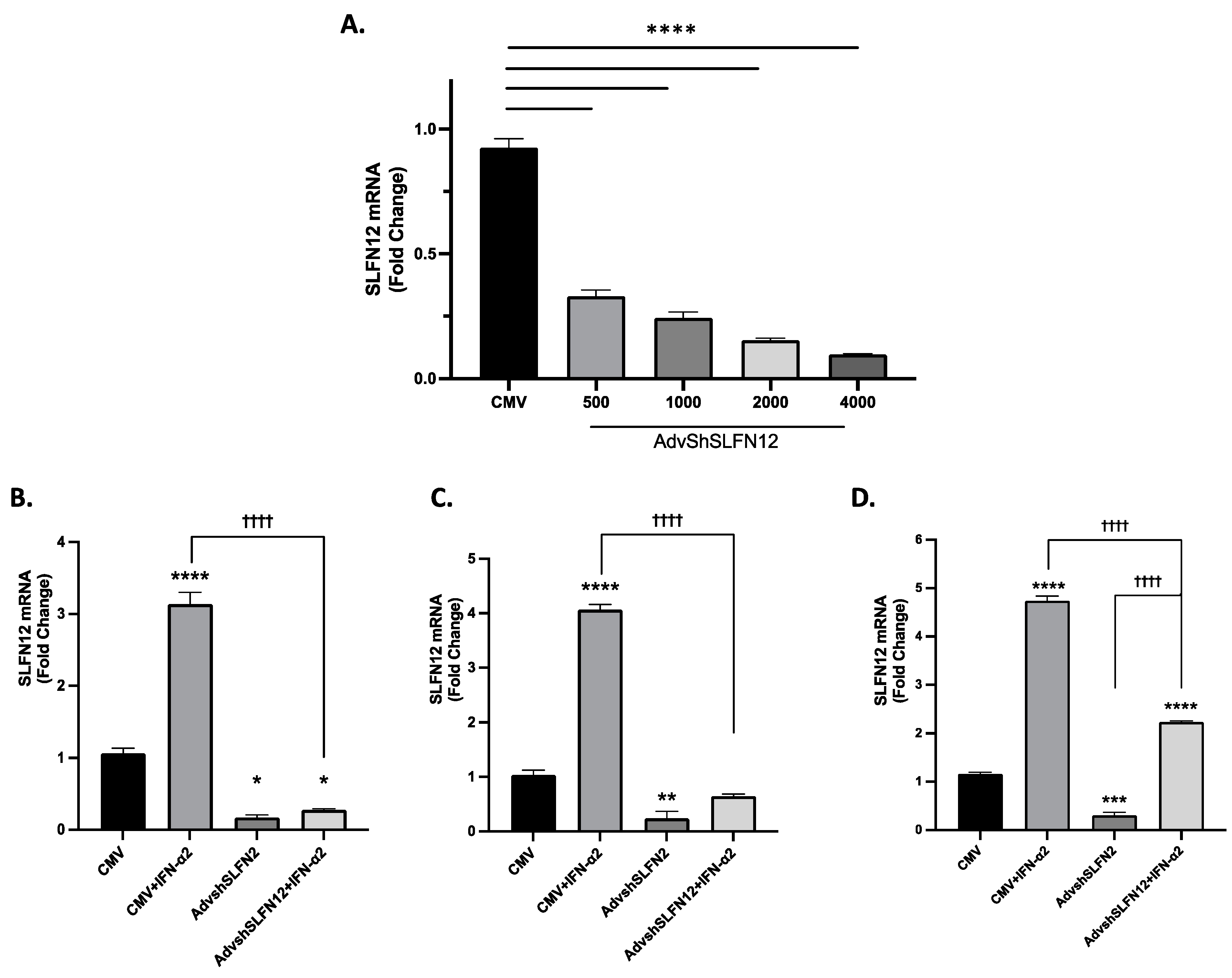
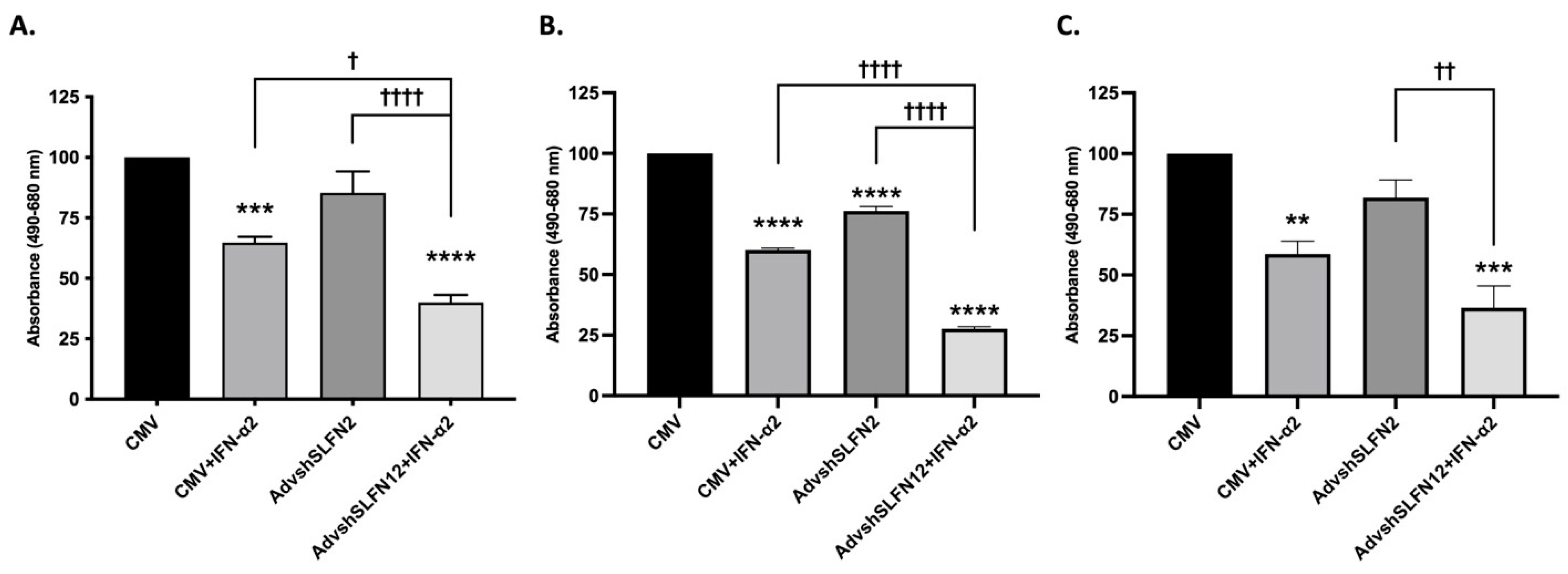
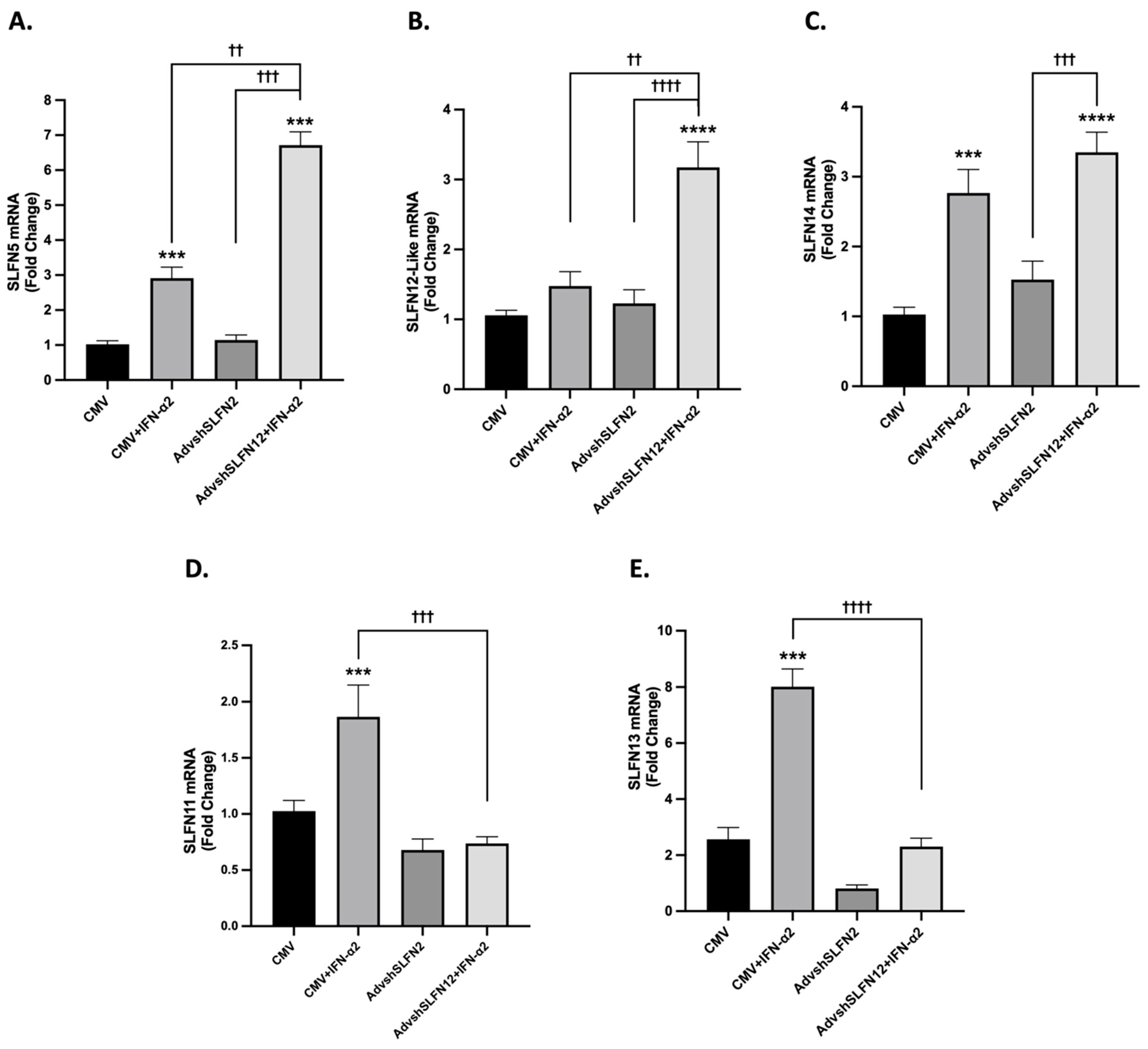
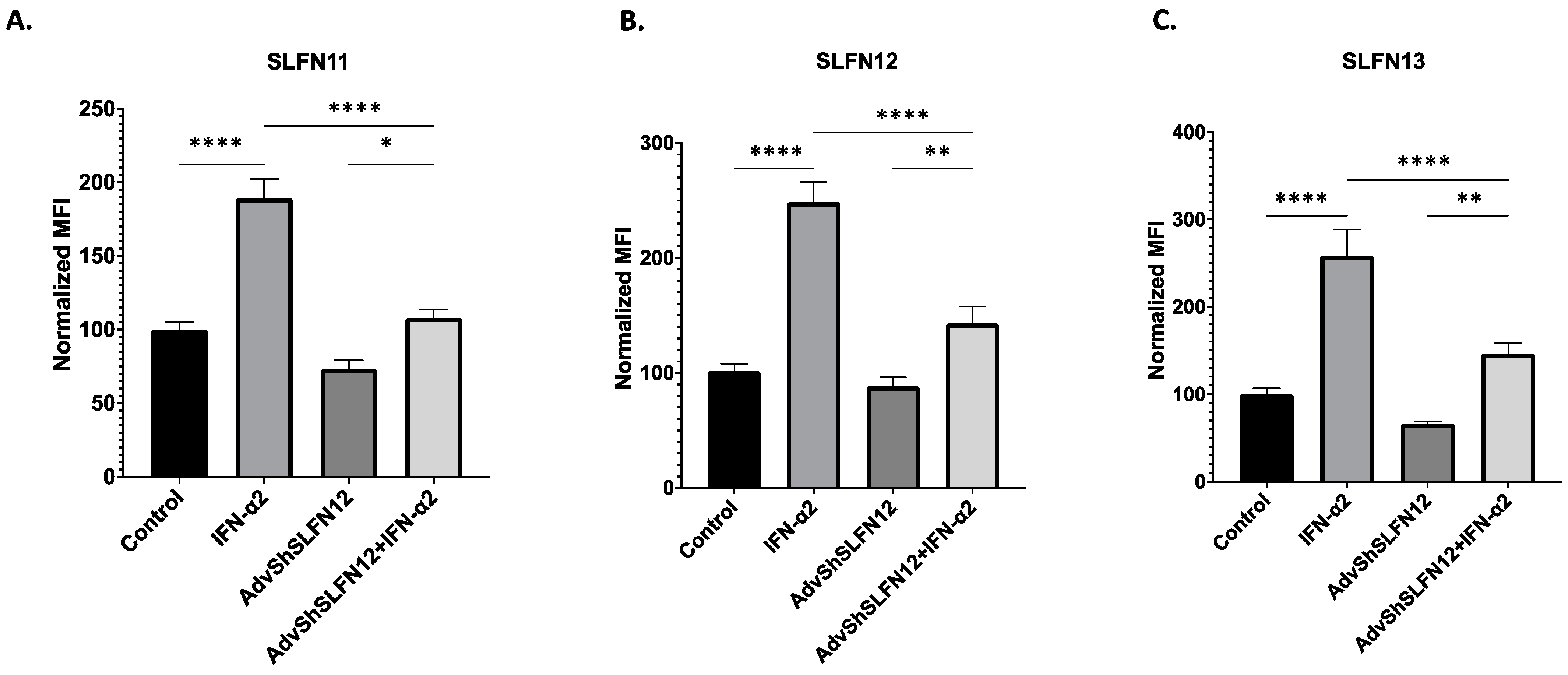
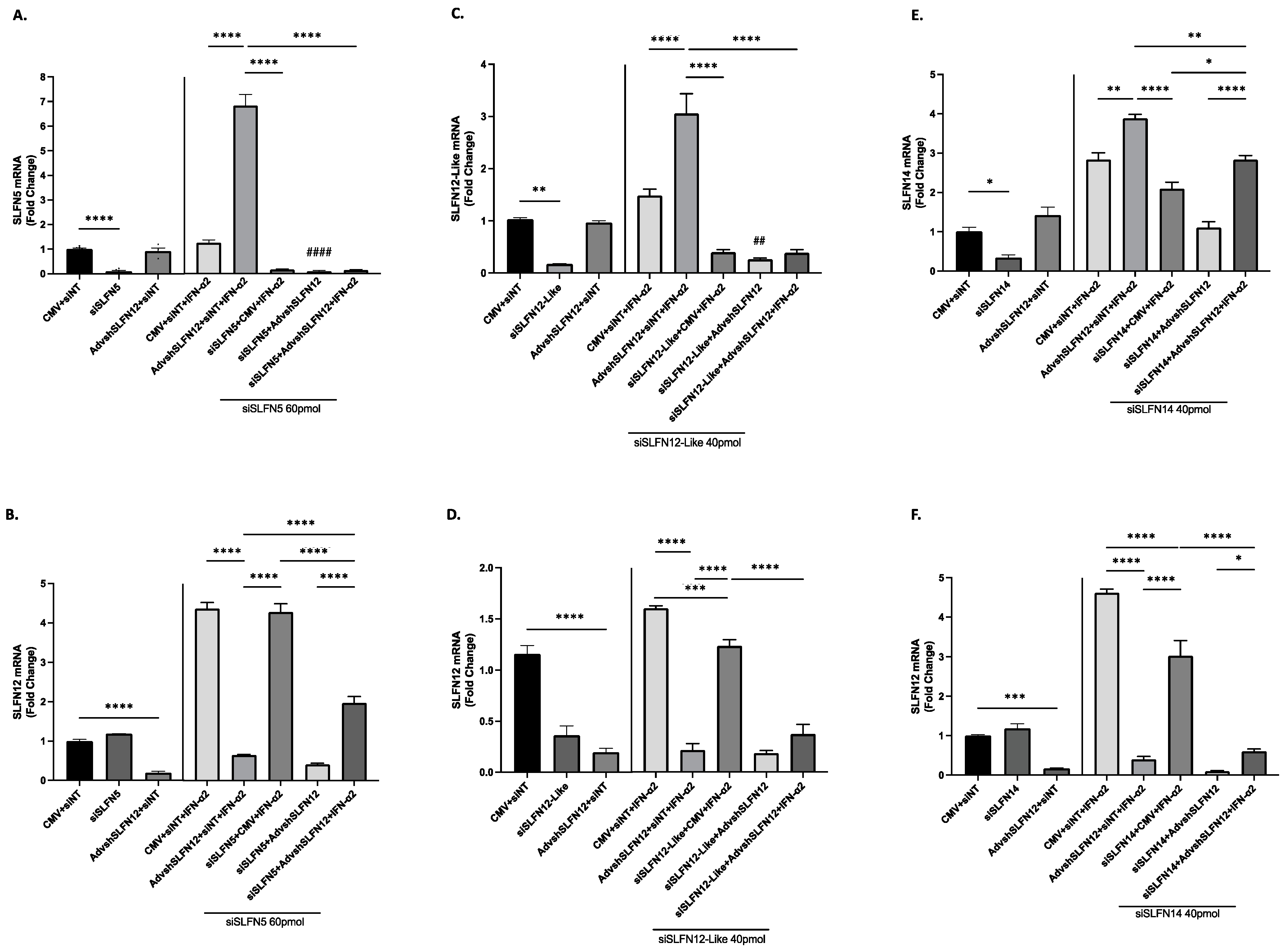
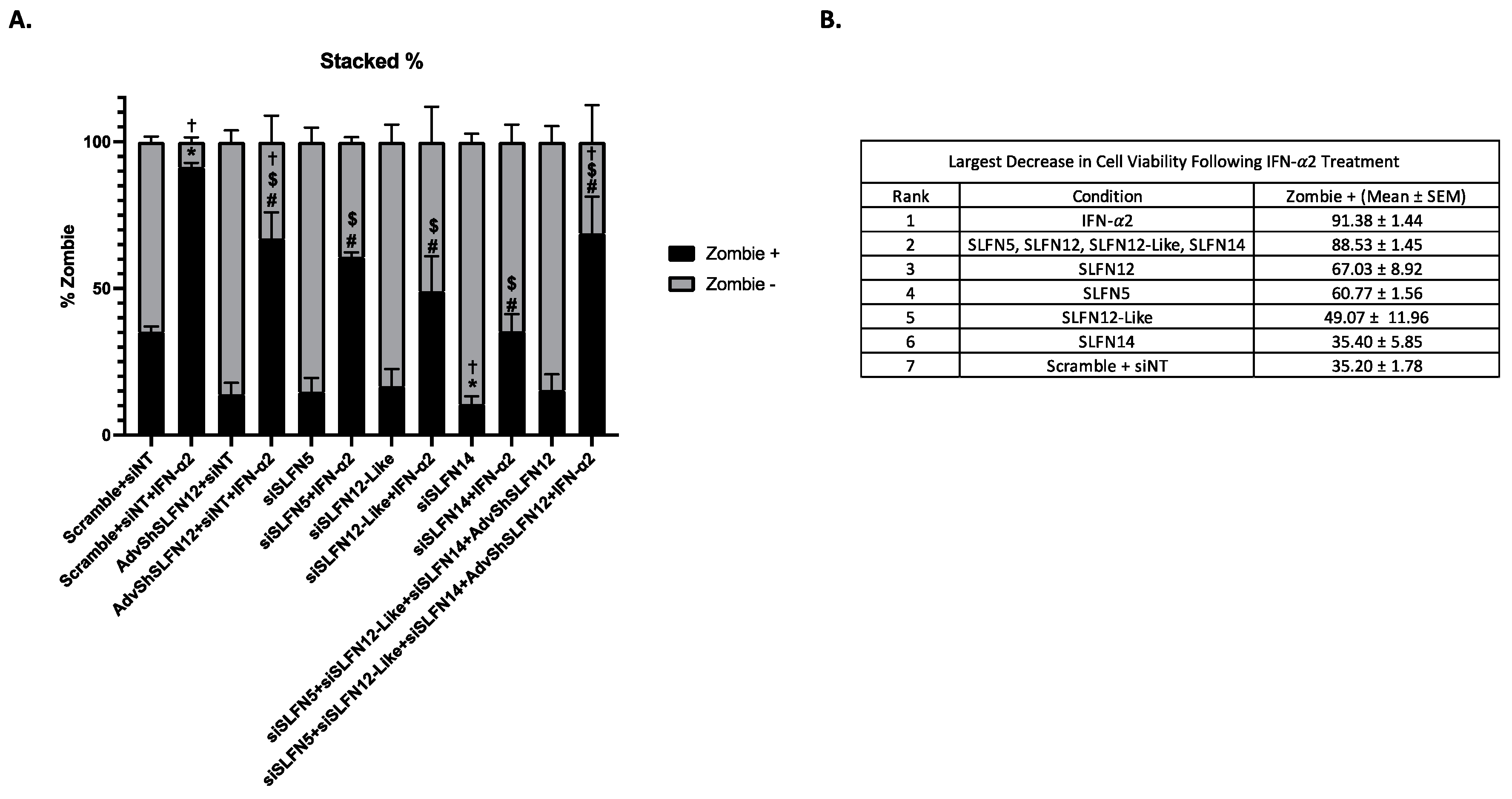
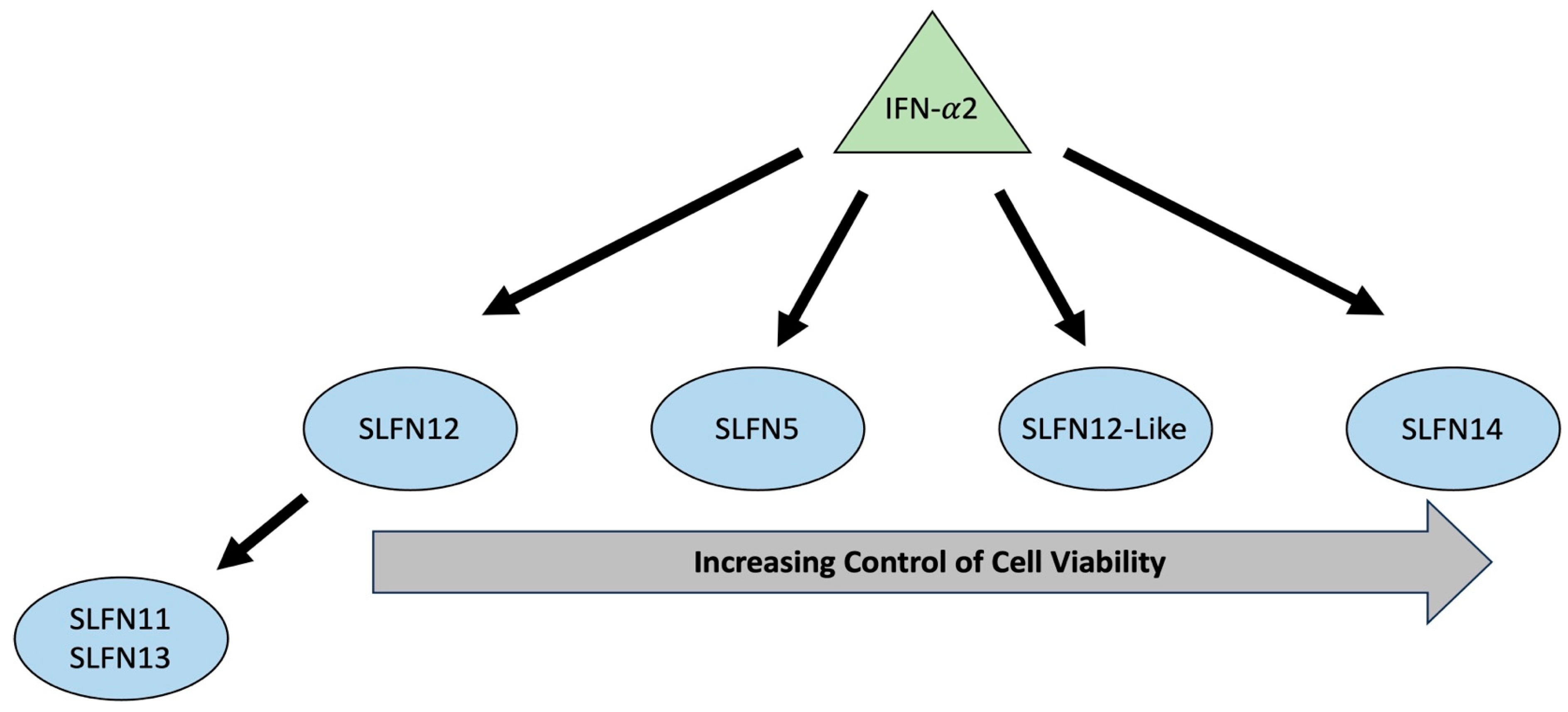
| IFN-α vs. AdvShSLFN12 + IFN-α | AdvShSLFN12 vs. AdvShSLFN12 + IFN-α | |||||
|---|---|---|---|---|---|---|
| MDA-MB-231 | BT549 | Hs-578T | MDA-MB-231 | BT549 | Hs-578T | |
| SLFN5 | ↑↑ | ↑↑ | ↑ | ↑↑↑ | ↑ | ↓↓ |
| SLFN11 | ↓ | ↓↓↓ | ↑ | - | - | - |
| SLFN12 | ↓↓ | ↓↓ | ↓ | - | - | ↑ |
| SLFN12-like | ↑ | ↑ | ↑↑ | ↑↑ | ↑ | - |
| SLFN13 | ↓↓↓ | ↑ | ↑ | ↑ | - | - |
| SLFN14 | - | ↑ | ↑↑ | ↑ | ↑ | ↑↑ |
Disclaimer/Publisher’s Note: The statements, opinions and data contained in all publications are solely those of the individual author(s) and contributor(s) and not of MDPI and/or the editor(s). MDPI and/or the editor(s) disclaim responsibility for any injury to people or property resulting from any ideas, methods, instructions or products referred to in the content. |
© 2023 by the authors. Licensee MDPI, Basel, Switzerland. This article is an open access article distributed under the terms and conditions of the Creative Commons Attribution (CC BY) license (https://creativecommons.org/licenses/by/4.0/).
Share and Cite
Brown, S.R.; Vomhof-DeKrey, E.E.; Al-Marsoummi, S.; Brown, N.D.; Hermanson, K.; Basson, M.D. Schlafen Family Intra-Regulation by IFN-α2 in Triple-Negative Breast Cancer. Cancers 2023, 15, 5658. https://doi.org/10.3390/cancers15235658
Brown SR, Vomhof-DeKrey EE, Al-Marsoummi S, Brown ND, Hermanson K, Basson MD. Schlafen Family Intra-Regulation by IFN-α2 in Triple-Negative Breast Cancer. Cancers. 2023; 15(23):5658. https://doi.org/10.3390/cancers15235658
Chicago/Turabian StyleBrown, Savannah R., Emilie E. Vomhof-DeKrey, Sarmad Al-Marsoummi, Nicholas D. Brown, Kole Hermanson, and Marc D. Basson. 2023. "Schlafen Family Intra-Regulation by IFN-α2 in Triple-Negative Breast Cancer" Cancers 15, no. 23: 5658. https://doi.org/10.3390/cancers15235658
APA StyleBrown, S. R., Vomhof-DeKrey, E. E., Al-Marsoummi, S., Brown, N. D., Hermanson, K., & Basson, M. D. (2023). Schlafen Family Intra-Regulation by IFN-α2 in Triple-Negative Breast Cancer. Cancers, 15(23), 5658. https://doi.org/10.3390/cancers15235658








